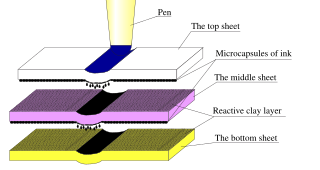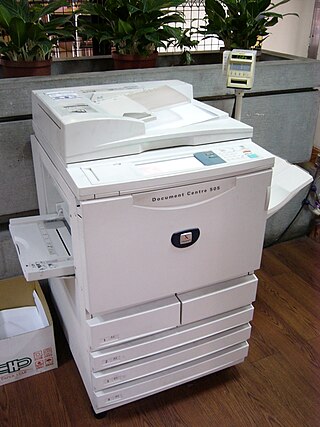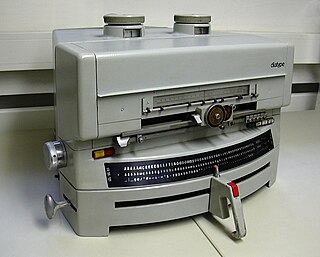
Ethanol is an organic compound with the chemical formula CH3CH2OH. It is an alcohol, with its formula also written as C2H5OH, C2H6O or EtOH, where Et stands for ethyl. Ethanol is a volatile, flammable, colorless liquid with a characteristic wine-like odor and pungent taste. It is a psychoactive recreational drug, and the active ingredient in alcoholic drinks.

A mimeograph machine was a low-cost duplicating machine that worked by forcing ink through a stencil onto paper. The process was called mimeography, and a copy made by the process was a mimeograph.

Waxes are a diverse class of organic compounds that are lipophilic, malleable solids near ambient temperatures. They include higher alkanes and lipids, typically with melting points above about 40 °C (104 °F), melting to give low viscosity liquids. Waxes are insoluble in water but soluble in nonpolar organic solvents such as hexane, benzene and chloroform. Natural waxes of different types are produced by plants and animals and occur in petroleum.
Duplicating machines were the predecessors of modern document-reproduction technology. They have now been replaced by digital duplicators, scanners, laser printers and photocopiers, but for many years they were the primary means of reproducing documents for limited-run distribution. The duplicator was pioneered by Thomas Edison and David Gestetner, with Gestetner dominating the market up until the late 1990s.

Butanone, also known as methyl ethyl ketone (MEK) or ethyl methyl ketone, is an organic compound with the formula CH3C(O)CH2CH3. This colorless liquid ketone has a sharp, sweet odor reminiscent of acetone. It is produced industrially on a large scale, but occurs in nature only in trace amounts. It is partially soluble in water, and is commonly used as an industrial solvent. It is an isomer of another solvent, tetrahydrofuran.

Carbon paper consists of sheets of paper that create one or more copies simultaneously with the creation of an original document when inscribed by a typewriter or ballpoint pen.

A permanent marker or indelible marker is a type of marker pen that is used to create permanent or semi-permanent writing on an object.

The hectograph, gelatin duplicator or jellygraph is a printing process that involves transfer of an original, prepared with special inks, to a pan of gelatin or a gelatin pad pulled tight on a metal frame.

Diethyl ether, or simply ether, is an organic compound in the ether class with the formula C4H10O, (CH3CH2)2O or (C2H5)2O, sometimes abbreviated as Et2O. It is a colourless, highly volatile, sweet-smelling, extremely flammable liquid. It is commonly used as a solvent in laboratories and as a starting fluid for some engines. It was formerly used as a general anesthetic, until non-flammable drugs were developed, such as halothane. It has been used as a recreational drug to cause intoxication.

White spirit (AU, UK and Ireland) or mineral spirits (US, Canada), also known as mineral turpentine (AU/NZ), turpentine substitute, and petroleum spirits, is a petroleum-derived clear liquid used as a common organic solvent in painting. There are also terms for specific kinds of white spirit, including Stoddard solvent and solvent naphtha (petroleum). White spirit is often used as a paint thinner, or as a component thereof, though paint thinner is a broader category of solvent. Odorless mineral spirits (OMS) have been refined to remove the more toxic aromatic compounds, and are recommended for applications such as oil painting.

Carbonless copy paper (CCP), non-carbon copy paper, or NCR paper is a type of coated paper designed to transfer information written on the front onto sheets beneath. It was developed by chemists Lowell Schleicher and Barry Green, as an alternative to carbon paper and is sometimes misidentified as such.

The Gestetner is a type of duplicating machine named after its inventor, David Gestetner (1854–1939). During the 20th century, the term Gestetner was used as a verb—as in Gestetnering. The Gestetner company established its base in London, filing its first patent in 1879. The business grew, remaining within the control of the Gestetner family, and acquiring other businesses. In 1995, the Gestetner company was acquired by the Ricoh Corporation of Japan.

Rubber cement is an adhesive made from elastic polymers mixed in a solvent such as acetone, hexane, heptane or toluene to keep it fluid enough to be used. This makes it part of the class of drying adhesives: as the solvents quickly evaporate, the rubber solidifies, forming a strong yet flexible bond.

David Gestetner was the inventor of the Gestetner stencil duplicator, the first piece of office equipment that allowed production of numerous copies of documents quickly and inexpensively. He also invented a new kind of nail clipper. Gestetner was awarded the John Scott Medal by The Franklin Institute in 1888.

The Photostat machine, or Photostat, was an early projection photocopier created in the decade of the 1900s by the Commercial Camera Company, which became the Photostat Corporation. The "Photostat" name, which was originally a trademark of the company, became genericized, and was often used to refer to similar machines produced by the RetinalGraph Company.
Thermo-Fax is 3M's trademarked name for a photocopying technology which was introduced in 1950. It was a form of thermographic printing and an example of a dry silver process. It was a significant advance as no chemicals were required, other than those contained in the copy paper itself. A thin sheet of heat sensitive copy paper was placed on the original document to be copied, and exposed to infrared energy. Wherever the image on the original paper contained carbon, the image absorbed the infrared energy when heated. The heated image then transferred the heat to the heat sensitive paper producing a blackened copy image of the original.

A photocopier is a machine that makes copies of documents and other visual images onto paper or plastic film quickly and cheaply. Most modern photocopiers use a technology called xerography, a dry process that uses electrostatic charges on a light-sensitive photoreceptor to first attract and then transfer toner particles onto paper in the form of an image. The toner is then fused onto the paper using heat, pressure, or a combination of both. Copiers can also use other technologies, such as inkjet, but xerography is standard for office copying.

Spokane Natural was an underground newspaper published biweekly in Spokane, Washington from May 5, 1967, to November 13, 1970, by the Mandala Printshop, and edited by Russ Nobbs. It belonged to the Underground Press Syndicate and the Liberation News Service. The first issue was produced out of a converted barbershop storefront cum bookstore and hangout called the "Hippie Mission" on a cul-de-sac in Spokane, where Russ Nobbs and a visiting friend from the SF Bay area, Ormond Otvos wrote and produced the first 8-page issue on a hand-cranked Spirit duplicator. After several issues of pale blue "Ditto" print on white paper, The Natural moved to colored papers and occasionally colored ink with a Gestetner Mimeograph duplicator. Ultimately, the newspaper was printed on newsprint by sheet fed or web presses by various printers in Spokane, Seattle and Davenport, WA.

A Diatype is a manual "typesetter machine" used for the phototypesetting of texts, printing them on a light-sensitive film, that can be used in different environments of the graphic arts industry.




















